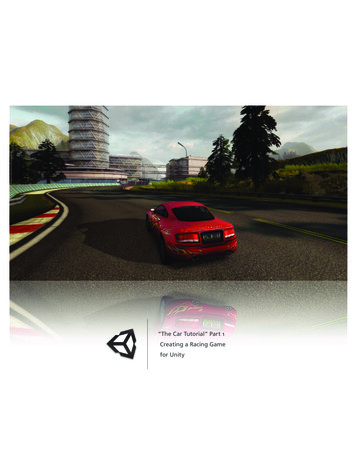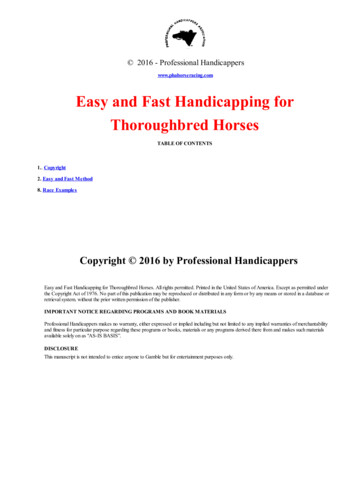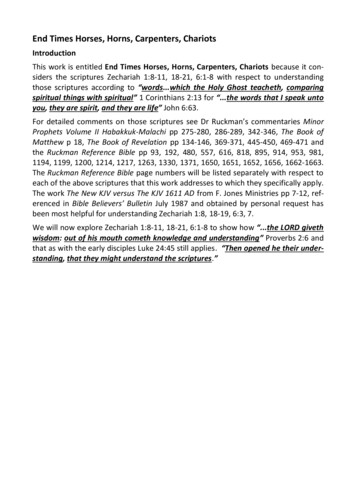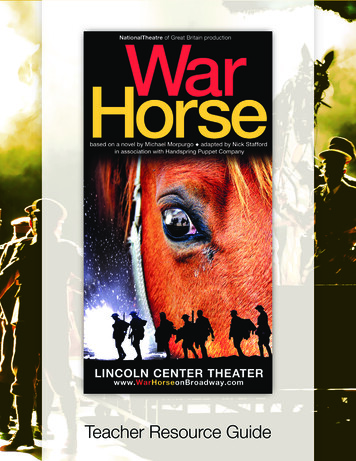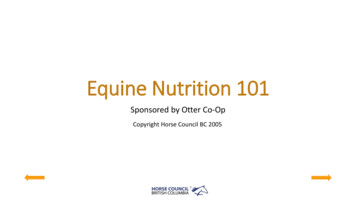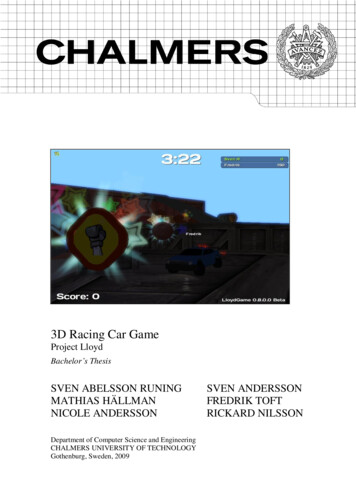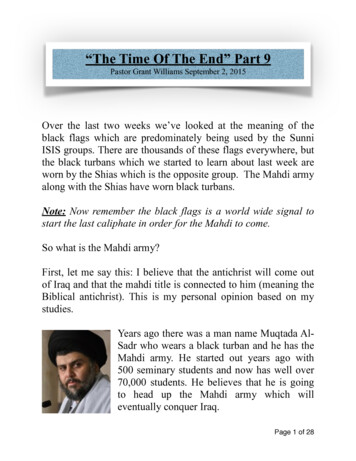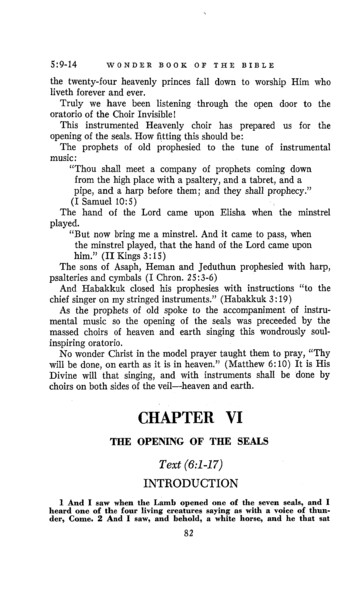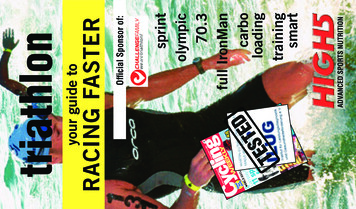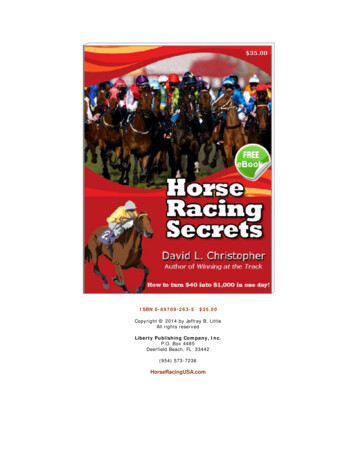
Transcription
ISBN 0-89709-263-5 35.00Copyright 2014 by Jeffrey B. LittleAll rights reservedLiberty Publishing Company, Inc.P.O. Box 4485Deerfield Beach, FL 33442(954) 573-7236HorseRacingUSA.com
Horse Racing SecretsDavid L. ChristopherIntroductionMy interest in horse racing dates back a long time – fifty years infact. In the summer of 1962 I was sitting in my bedroom of ourfraternity with a large stack of Morning Telegraph newspapers, nowcalled the Daily Racing Form.The challenge of devising ahandicapping method that I could apply when I ventured toAqueduct racetrack was daunting.After many days of study I discovered a simple system that I couldcalculate quickly and enter into the margins of my newspaper. Itwas a clever, easy, and reliable shortcut; but nothing compared tomy far more accurate computer method of today.Many years later we moved to Baltimore where I visited Pimlico,Laurel, and Bowie (which is now nothing more than a trainingtrack). At that time one of my racing friends was the late JoeFinley (a.k.a. William L. Scott), author of three popular booksincluding How Will Your Horse Run Today? and Total Victory at theTrack – both published and marketed nationwide by my publisher.By the time Joe and I became friends my method had been refinedconsiderably and published as a book that sold well over 70,000copies which was later introduced as a unique computer program.Both were titled Winning at the Track. The book, no longeravailable, but soon to be an e-Book, could never keep up with theadvances I continued to make with the software – even to this day.In addition to Winning at the Track I have been writing for years onthis subject and this e-Book includes some of that writing.Finally, serious and skeptical handicappers should note that thesubtitle to this e-Book (How to turn 40 into 1,000 in a day!) isreally not an exaggeration. That is, providing that you will applymy overall strategy of handicapping for CONTENDERS rather thanattempting to only pick WINNERS as Joe Finley, Andy Beyer, andmany other good handicapping/authors have long preferred doing.Horse racing is a great sport! It is so much more fun than sittingat a noisy table watching a little ball and a wheel steal your money.Handicapping requires some intelligence and a little thinking.Note: This free e-book illustrates the primary examples used in theWinning at the Track online demo.
The “Shortcut” MethodAfter well over 70,000 book copies, it can now be said that the "shortcut"version of the Performance Method proved to be a popular tool for thecasual racing fan. But the introduction of the WINNING AT THE TRACK(WATT) computer software in 1985 marked a real milestone for all seriousspeed & pace handicappers in today’s world of live, simulcast, and onlinebetting.Today, WATT is clearly the gold standard for speed/pacecomputer handicapping.With the shortcut method an entire race card can be completed in lessthan two hours, either written neatly on pre-printed forms, or in a morehurried manner in the newspaper's margins next to each horse's name.Although it is far more time-consuming compared to the computer, andthe adjustments are crude by today's standards, the manual version stillworks to a great extent and provides some utility for casual handicapping.In the original Winning at the Track text, there is a "Basis Times" table.The figures illustrated are, in effect, a composite of three great horses –the three greatest of our generation – Dr. Fager for sprints, Damascusfor the mid-distance routes, and Secretariat for the longer, classicroutes. The modern version of the “Performance Method” and the final“PM Ratings,” as we now call them, begins with this table.From these basis times, a "parallel speed table" was developed andincorporated into the computer program. Also, from these numbers,Surface Adjustment Tables can be created for the non-computer version ofthe Performance Method.This is the original BASIS TIMES Table:For explanations to create a complete Adjustment Table for all distancesrefer to the Winning at the Track book, which can be found in some publiclibraries, although the book is, after many years, finally out of print.However, to make the calculations that are explained in this section, thefollowing Adjustment Table on the next page shows a rough example ofhow it would appear. Also, at some point in the future, an e-Book of theoriginal Winning at the Track paperback will be published, although that isnot a priority at this time.
4Speed Rating Surface Adjustments5 1/2f6f7f1 1/16 mi.Gulfstream Park-1-40-5Tampa Bay-8-8- 11- 18- 11-9-9- 16CalderEach adjustment above represents the number of fifths of a second that atrack's record, at each respective distance, is slower than that recorded onthe basis times table. If the 6-furlong track record at Calder is, forexample, 1:08.4, then the adjustment is -9 points (minus 9/5ths) becausethe basis times table figure is 1:07. The Daily Racing Form calculates itsspeed ratings from the track's best time within the past three years.However, the historical track record is preferred for consistency.When using these calculations, it is important that every horse from thesame track is adjusted exactly in the same manner. Users of theWINNING AT THE TRACK software can create such a table by applying theprogram’s Pure Speed adjustment relationships.Here's how the "short cut" version is calculated:First, the Ability Factor is established for each horse by merely addingthe DRF speed ratings and track variants together for the last three racesat today's distance (or close to it). Then make a small weight adjustment.Next, the Condition Factor is found by adjusting the last DRF speedrating at today's distance (or closest to it) with the appropriate figurefound on the Adjustment Table, adding either a 21 (fast) or 25 (slow)surface variant to it, and then making a minor change for weight.The final P/M Rating for each horse is simply a total of the ABILITYFACTOR and the CONDITION FACTOR added together. The two highestfigures in each category and the three best totals are circled. The topcontenders almost always emerge among the four horses that comparemost favorably. In the end, always rank the three or four top selections inthe order of expected finish.Wagering suggestions for these and other handicap methods will bediscussed in greater detail later.One of the problems with the manual (shortcut) approach is the inabilityof the handicapper to properly adjust various distances whenever thenecessary figures aren't readily available. For example, if the animal isrunning today's distance for the first time, or hasn't run today's distancein many months, it enhances the risk of the "shortcut" version; whereasthe computer can readily adjust every past performance line. It's idealwhen every entry has been competing recently under today's conditions.But then, other race goers will also enjoy the same ease of comparison,which will inevitably result in "chalk" (low pay) selections occurring moreoften. With computer adjustments, we are seeing facts others miss.
5For those who do not have the original Winning at the Track book handy,below are the seven basic steps to the "shortcut" version to illustrate howthe P/M Table should be completed manually. A blank P/M Table formanual calculations can be found on the last page of the book. A tablejust like it can be created and easily duplicated. One copy should be madefor each race being handicapped. Also, see another e-Book that I wroteentitled The Gold Book of Handicapping.Step 1. For each horse, fill in the basics on the table: the horse's name,the date of the last race, and the weight that will be carried today.In the newspaper, for each horse, place a check next to each of the threeraces that will be used to calculate the Ability Factor. Remember, theobjective here is to select the three most recent races that most closelyapproximate the distance that will be run today. This checking procedureis not absolutely necessary, but these notations will help you calculatemore quickly and to easily return to these figures if any questions ariselater.Also, for each horse, underline the most recent race of the same distanceas today's race. When the distances are significantly different the riskbecomes greater. In addition, it is easier to ask a horse to run slowerthan it is to demand more speed.Step 2. In the appropriate column, enter the total of the three SpeedRatings and three Track Variants that were previously checked. Do notadjust these figures; just enter the total of the six numbers that appear inthe newspaper. If there is only one race, simply multiply that race total bythree; or 1.5, if there are two races; and add an “a,” noting that the figurewas "adjusted."Step 3. Calculate the weight differences for those three races versustoday's contest (maximum 2 pounds per race, or 4 pounds total) in theweight adjustment column. The totals from Step 2 and Step 3 are thencombined to produce the Ability Factor, which is entered in the nextcolumn. However, do not consider weight to be a critical item. It is not.Step 4. For each horse, enter the Speed Rating for the most recent racehaving the same distance as today's contest. Do not adjust the SpeedRating – use the number as it appears in the newspaper. If this SpeedRating occurred on a "fast" track, enter a "21" in the next column. If itwas an off track (anything slower than a fast track), enter a "25" in thatcolumn.Step 5. It is worth the time and effort to construct a Speed RatingAdjustment Table for each distance. A Table should be made for at leasteach of the following distances: 6 furlongs, 7 furlongs, and 1 1/16 miles,depending upon your local racing circuit. Identify the name of the trackon which the Speed Rating in Step 4 was accomplished. Using theappropriate Speed Rating Adjustment Table, enter the track adjustment inthe designated column.
6Step 6. Combine the figures in Steps 4, 5, and 6 to arrive at a ConditionFactor, which is then entered in the appropriate column.Step 7. Fill in the "Total" column by adding the Ability and ConditionFactors. Later, at the track, note the horses' post time weights for today'srace. If the weights differ from the preliminary weights listed in Step 1,adjust the Totals accordingly. Adjust the weight difference by a maximumof 3 or 4 pounds, depending on judgment. Treat ALL horses the same.Next, just circle the two best Ability Factors and the two best ConditionFactors, along with the three best Totals. Use arrows to note othersignificant figures for quick and easy reading. If two horses have anidentical Ability Factor, Condition Factor, or Total, circle both. Experiencedhandicappers can rightfully argue that weight is of much less significancein the real world than it appears in these calculations. However, there is agreat reluctance to “fix what ain’t broken.”Finally, there is the question of postposition. Both the shortcut methodand the computer program ignore this factor. There are, however, twocases when postposition can be important and they should not beoverlooked with handicapping the race: First, when the starting gate isnear a turn, posts 9 - 12 can result in a loss of a few lengths if the horseis carried wide around the entire turn. Second, on a wet or drying track,post 1 can slow a horse, although early speed at the rail is usually abenefit. On the other hand, late speed horses are always placed at adisadvantage when they draw post 1 or 2 in a large field.Exactly why this shortcut version of the Performance Method works as wellas it does has always been a mystery to me. It has worked wellconsistently for nearly fifty years and I never hesitate recommending it tonewcomers. Admittedly, though, 99% of my handicapping today is withthe computer which is faster and a far more accurate approach.Remember, it’s a Horse "Race"Racing fans sometimes forget that the outcome of a contest depends notonly on ONE selected horse, but on the capabilities of the OTHERS as well.It is the talent relationship between one horse and all the others in thecontest rather than how fast the animal can run. If our horse is fast, butall the others in the field can run faster, our pick is likely to lose the race.As a typical example, look at the following computer graphics screens fortwo different races, in each of which Kings Antics was a contender. Inthe first match-up, he was in postposition #4 and declared the bettingkey. In the second race, he was #7 and not the clear choice.
7His performances should not have been any surprise. He won the firstrace. But in the second contest, the #5 and #8 were the victors. Someraces are just more contentious than others.“Stick-outs”When one horse has a statistical advantage over others in the field, theonly two questions that can arise are: (1) Will the jockey mess this up?(2) What kind of bad racing luck can ruin this opportunity? The greaterthe horse’s talent advantage, the smaller the chance that it will fail.Identifying a stick-out is an important factor whether you are using aprogram such as Winning at the Track or handicapping the contest by anyother means. Remember, too, that it is a positive when you encounterstick-outs of two or three horses. However, this usually means that thebetting scheme should be altered.
8Above is a lower-risk situation, almost regardless of the pace. And itdoesn’t take a rocket scientist to see which horse will most likely romp –and he did just that. The surprise was that his winning ticket paid 14.00.Deciding the best way to bet races such as these, however, involvesrecognizing the situation, knowing the odds, and often a large dose ofexperience that is learned the hard way most of the time. Unfortunately,this e-Book can’t teach that.Know the SurfaceThis is a cardinal rule for successful handicapping. And it is true whetheryou are watching live or simulcast races.The most ideal surface is a fast, dry dirt surface. While it differs – oftensubstantially – between one racetrack and another, it presents the leastamount of uncertainties for the handicapper.A sloppy track favors early speed, not because they run faster on themore exposed base surface (they all do) but because mud is not splashedin their faces as often during the contest. Moreover, the added weight ofcaked mud on their bodies is less of a burden.A muddy and heavy drying track tends to benefit the closer more often. Itusually reduces the distance between the pacesetters and the closers.A firm turf, like a dry dirt surface, presents fewer uncertainties. A soft oryielding grass course adds numerous uncertainties. Thus, past races rununder such conditions are much more difficult to judge. A horse that hasrun on a yielding grass surface might be the fastest horse in the race andyou (or the computer) cannot tell by the reported numbers.Finally, it is important to remember that some horses favor one surfaceversus the other. Most horses that run well on the dirt can run well on afirm turf. Many horses that run well on the grass do not necessarily runwell on the dirt. When analyzing a dirt race it is usually a good idea toremove turf lines from the handicap.
9How Fast Can a Horse Run?Handicappers have forever attempted to measure a horse’s speed – and ina number of different ways.Perhaps the best way is to divide each race into three segments as I havedone since my work began in 1962. That is, measuring the horse’sperformance to the first call point in the contest, then to the second call,and then, finally, during the last quarter mile ending at the finish line.First, measure the horse’s Early Speed (the ability of the horse to run justafter leaving the starting gate and judge its speed in the first portion ofthe race (to the first call) and then between the first and second calls.The second call of most “sprints” is 4 furlongs (1/2 mile) while the secondcall of most “routes” (longer races) is 6 furlongs (3/4 of a mile). A horse’sLate Speed is a rating given to that portion after the second call.The one, two, or three horses that are leading the field in the early portionup to the second call point can be referred to as the “pacesetters.”Years ago, I coined the term for a horse’s speed between the starting gateand the second call point as the “Pole Speed.” Any horse with the fastestPole Speed rating during the race is a pacesetter.The general rule used by handicappers is that a horse runs the length ofits body in about 1/5 of a second. Therefore, each second of time isdivided into fifths, even though a clocker’s time can also be a meaninglesstenth of a second.The following chart excerpt illustrates the past performances of Trinniberg,a heavy favorite in the 8th race at Calder (part of a later example).In this case, the graphic shows that on October 2, Trinniberg ran in asprint at Belmont. The speedy 3-year-old was the leader at the first callin 22 seconds, he continued as the pacesetter, leading at the half-milepole in 45 2/5 seconds, and he finished in second place, nearly one lengthbehind the winner, at the finish line. It is possible to assigned ratings ateach point in his race – here he has a Pole Speed of 93, and a LastQuarter calculation of 190. Combined, they produce a Late Speed Rating.
10Understanding the MultiplierBuy a 2.00 PLACE ticket on your key horse selection, watch him win orfinish second, and then collect 3.20 at the window. This doesn’t soundvery exciting. Right?But if you make a similar wager FIVE TIMES in succession during thecourse of the day and re-invest (parlay) your winnings each time, aninitial 40 place ticket will gain in value to more than 400 after fiveconsecutive wagers. Moreover, if the average payoff is 4.00 rather than 3.20, a distinct possibility, the original 40 can become almost 1,300!Do you still find this unexciting?First and foremost, the handicapper should understand and appreciate thepower of “compounding values.” Just notice how quickly 1 can growwhen it is doubled only five times: 2, 4, 8, 16, 32. In this case,the constant “multiplier” is 2. If the constant multiplier is only 1.5 thegrowth sequence is much lower: 1.50, 2.25, 3.38, 5.06, and 7.59.Anyone with a savings account or a large balance with a credit cardcompany already knows that compounding numbers can becomesignificant very quickly. The profit that you enjoy in every race dependson the all-important multiplier.It is nearly impossible to predict exactly how much profit can be obtainedwith a place ticket in any given race because the payoff depends on whichtwo horses comprise the exacta and the monies in the place pool at posttime. The winning ticket holders divide this pool when the race ends.For this reason, we set a “target” multiplier for each round and hope forthe best. The return to bet to win or to place is sometimes disappointing,but you can also be pleasantly surprised; and oftentimes substantially so.The multiplier also applies to exotic wagering. For example, if you bet 12 on three horses in a 2 exacta box and cash a 36 ticket, yourmultiplier is 3.00. It’s that simple. The fastest way to lose money at theracetrack is to ignore the multiplier, regardless of which betting schemeyou happen to use. Watch the potential return versus the investment.A Day at the TrackTo illustrate a typical day at the track I have randomly selected oneSaturday at Calder Racecourse in South Florida. On this particular day(July 7, 2012) there were twelve races on the card – nine on the dirt andthree on the turf. For reasons to be explained shortly, I dismissed five ofthe twelve races to accommodate my primary betting scheme.The table below illustrates the three highest rated horses identified byWinning at the Track. The program actually displays FOUR in each contestbut this graphic was made shorter for the sake of simplicity. Besides, yourpotential key horse normally appears in the top three of the Best-4 about85-90% of the time anyway. After all, it is easier to handicap threehorses than it is eight, ten, or twelve.
11Generally speaking, this was a busy, low paying day. Seven of the day’stwelve exactas returned less than 25. However, the potential of turning 40 into 1,000 or more that afternoon was there for racing fans to enjoy.Handicapping at the racetrack is an individual thing. Every serious racingfan has a favorite approach. It matters little how you find the key horses.It only matters that you are successful in doing so. It is important thatyou have discipline and identify which races to play in order to avoid thosethat should NOT be played.Calder Racecourse (Florida)12-race Card – July 7, 2012Three Best PM-Ratings in Each RaceAs stated earlier, five of the twelve races were not included in my overallbetting scheme. I eliminated the three turf races (the 4th, the 7th, and the12th) because racing on the grass adds one additional risk element to thehandicap. Should all turf races be passed? Definitely not. In fact, the10-8 exacta in the twelfth race was a snap to handicap and it paid 188.The 1st race was passed because there were simply too many first-timestarters and only two contenders with viable numbers. Cat Five Hurricaneromped by 4 lengths in that contest, as expected, and paid 8.60 to win.In the 8th race, the 7-3 exacta paid 7.60 and those two beat the rest ofthe field by 13 lengths. The outcome was no surprise and simply tooobvious for everyone to see. The first two paid squat - with no show pool.
12Saturday’s Betting SchemeRecently, Liberty published a 30 e-Report entitled The Win/Place Parlay,which explains this betting scheme in greater detail. For those interestedin this approach, I suggest obtaining a copy.The Win/Place Parlay is a marvelous way to make big money at the trackwithout risking too much. There are ways to improve the multiplier as Iexplain in my e-Report. In any case, the tables below show how the ninedirt races at Calder panned out on that Saturday. Of course, everythingdepends on the handicap. This e-Book assumes that your method foridentifying the key horse is also successful, whether you are using thecomputer or not:Race 1Cat Five Hurricane won by a little more than 4 lengths, paid 8.60 to winand 2.60 to place, as shown above. The first-time starter, Aim to Win,was the heavy favorite. The 6-1 exacta returned 16.40.
13Race 2El Grande Monte was my other key candidate with a more promisingmultiplier. Unfortunately, Whining was the selection and romped by fivelengths. The 3-1 exacta paid a very nice 44.20.Race 3Coach Gravy, the favorite, won by seven and Zuber led by another threelengths. The 5-9 exacta paid 20.00.Race 4 on the turf was passed.
14Race 5Ladyfromhavana, the favorite, won by two, while The Grace of God wassecond favorite and led by another four. The 5-10 exacta ticket paid apaltry 16.20.Race 6Duty Blues, the second favorite, won by three and our key, Off the Jak,going to the post as the favorite, led the rest of the field by another three.These two were very equal in the handicap in most respects. The 7-8exacta ticket paid only 18.20 but, as the next graphic screen illustrates,the 55.20 trifecta (7-8-5) in the 6th race was a “snap.”
15Race 7 on the turf was passed.Race 8The public made Trinniberg the favorite, losing by a nose to Fort Loudon,the second favorite. At the wire, these two were 13 lengths in front of therest of the field. The 7-3 exacta ticket paid 7.60 and the trifecta paid 14, only enough to cover the cost of gasoline driving to the track. Thisrace was passed. This race was a good example of “speed” over “class.”Races such as this should be passed unless you are willing to make asmall wager on a Fort Loudon win ticket. The odds, nearly 2:1, werealmost tempting but not worth the risk of losing.
16Race 9Another Romance came from off the pace to beat the favorite, CitizenAdvocate, by two. This was an identical performance to one of two racesin which they met earlier. Selecting the key horse between these two wasdifficult. They appeared equal in many ways. Class handicappers at thetrack were tempted with #5. He was favored to beat the slightly faster#2. The 2-5 exacta ticket paid a respectable 36.00.In this contest, the 2-5-9 trifecta was very obvious to WATT users. It paida very handsome 165, but was a big disappointment since Redbud Roadbeat the longer shot (40:1) Sinister Tale by a nose.Race 10This was the toughest handicap of the day. Field Commission was a good7-year-old shipper from Canada running against others 4 years into theirprime. Gantry ran against the talented Shackleford in a Grade 2 last outand generally makes more money than all the others every time he races.
17Gantry beat Indiano and Close It Out (noses apart) by five and the 10-7exacta paid only 23.80. However, #2 went to the post at 50:1 and wasthe 4th choice in this race. The trifecta paid 267.60. Field Commissionfinished dead last in the 8-horse field.Race 11Unlike the prior race, this was an easier handicap. Nichole H was an easykey but she finished second behind the “classier” and favored MusicalRomance. The 5-9 exacta was 15.00 and the trifecta returned 134.20.Race 12One of the most interesting races on the card was the 12th and last one ofthe day. This 7½-turf race was passed, but the winner, Callmethesqeeze,and the place horse, Brinca, were both obvious contenders. The multiplierfor #8 was astronomical. The 10-8 exacta paid 188.40.Note: This race was handicapped in LPC’s Searching for Long Shots.
18It was a profitable day for anyone using a Win/Place Parlay but thepayoffs were disappointing. The list below shows the below averagemultipliers for my key horses for every dirt race on this particular ce1234567891011121.3x (passed)1.8x1.5x(Turf - passed)1.4x1.6x(Turf – passed)1.05x (passed)2.5x1.6x1.8x(Turf – passed)Late in the day, due to the difficulty of the handicap, a decision was madeto make the 11th race the final wager in the parlay rather than the 10th.But, either way, the decision proved to be profitable. The probabilities forsuccess were higher than normal for the entire day, and the final bankrollwas somewhat below expectations (a net profit of close to 1,000).Also, it is worth noting that the 12th race, a contest that was never difficultto handicap, was not included in the betting scheme because of thesurface. It produced an incredible multiplier of 7.3x and an exacta payoffof 188. As a general rule, when the odds are that appealing, the raceshould not be ignored altogether. Never underestimate the importance ofthe multiplier.
19More on WageringWagering is a critical and very personal aspect of profitable horse racehandicapping. Most important, of course, is the handicap itself. Butwagering also ranks right up there. A failure in either is good reason totake up golf instead. Moreover, the level of success in your handicappingcan determine how wagering should be done. To repeat, my approach isdirected to contender selections and I like parlays. When betting a horseto win, I prefer horses at 5:2 or better.One handicapping friend on Long Island has made a living with Bet-3’sand other wagers of that type. Another friend in Miami has had enormoussuccess by boxing selections from the “Pace Analyst” (a feature in Winningat the Track) to play superfectas. I use neither approach. However, bothare good WATT handicappers.When playing exactas and trifectas, my personal rules are very simple:Never play an exacta (or quinella) without a key horse and never play atrifecta without two horses that you “love.”With exacta boxes, favor three-horse boxes – not four or more. Withtrifectas, consider the part-trifecta wheel (A-B-All, and B-A-All, or specificselections beneath A and B). Superfectas are only for special situations.Class HandicappingIt is a fact that the majority of people who go to the racetrack losemoney. Also, most are “Class Handicappers” and it’s my experience thatvery few are successful. One of the best that I’ve met is David Rosenthal,author of The Complete Guide to Racetrack Betting. Included in hisoverall handicapping approach is the application of “trainer moves.” Sometrainers are just very good with certain strategies.Perhaps the most effective way to measure “class” is based on two simplecalculations: The Average Money Per Start and the Average Purseand analyzing the relationship between them.If the Average Money is high and the Average Purse is low, the trainer isplacing the horse in jeopardy of being claimed away.If the Average Purse is high and the Average Money is low, the racehorseis probably the family pet.The Average Money Per Start is a very simple division calculation involvingthe total amount of money earned and the total number of races that thehorse ran during the same time frame.The Average Purse calculation is a little more complex. The next formula,used in Winning at the Track, illustrates a good way racing fans can arriveat a single, easy-to-understand number.This is a rule worth remembering: Class is speed and speed is class.
20How to calculate the Average Purse:HORSEGold LimitTOTAL RACESWINSPLACESHOW26424TOTAL WINNINGS: 30,000Normal PercentShare of any Purse2 Wins6 Place4 Showx .60x .20x .10TOTALNumber of Purses 1.21.20.42.8 30,000 Total Winnings divided by 2.8 10,714 average purse* * *For any readers interested, these are the Average Money Per Start andthe Average Purse numbers for the race card discussed earlier. TheWinning at the Track speed/pace program ranked the horses in each race.Race 2Race 3Race 5Race 6
21Race 8Race 9Race 10Race 11Race 12ConclusionGenerally speaking, the horse racing industry has seen a gradual declinein recent years largely due to sharply increased competition from casinogambling. However, this pari-mutuel sport is likely to enjoy resurgence inthe years ahead simply because it challenges the human mind. Successat the cashier’s window depends on your
Step 7. Fill in the "Total" column by adding the Ability and Condition Factors. Later, at the track, note the horses' post time weights for today's race. If the weights differ from the preliminary weights listed in Step 1, adjust the Totals accordingly. Adjust the weight differe
